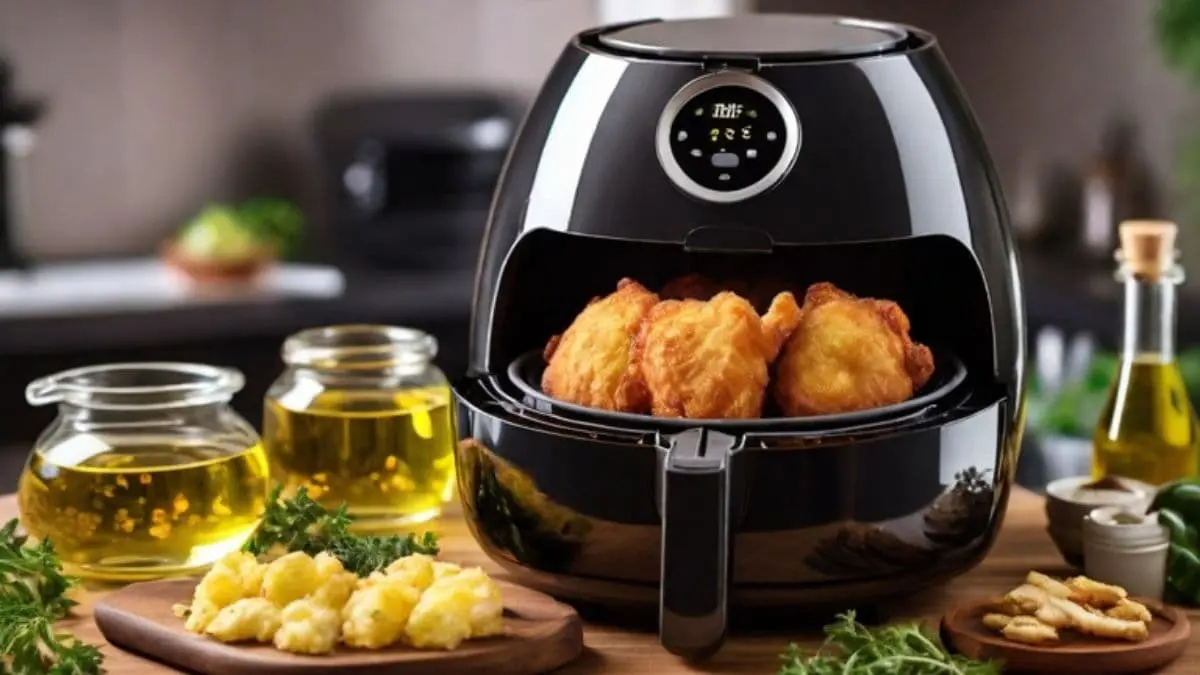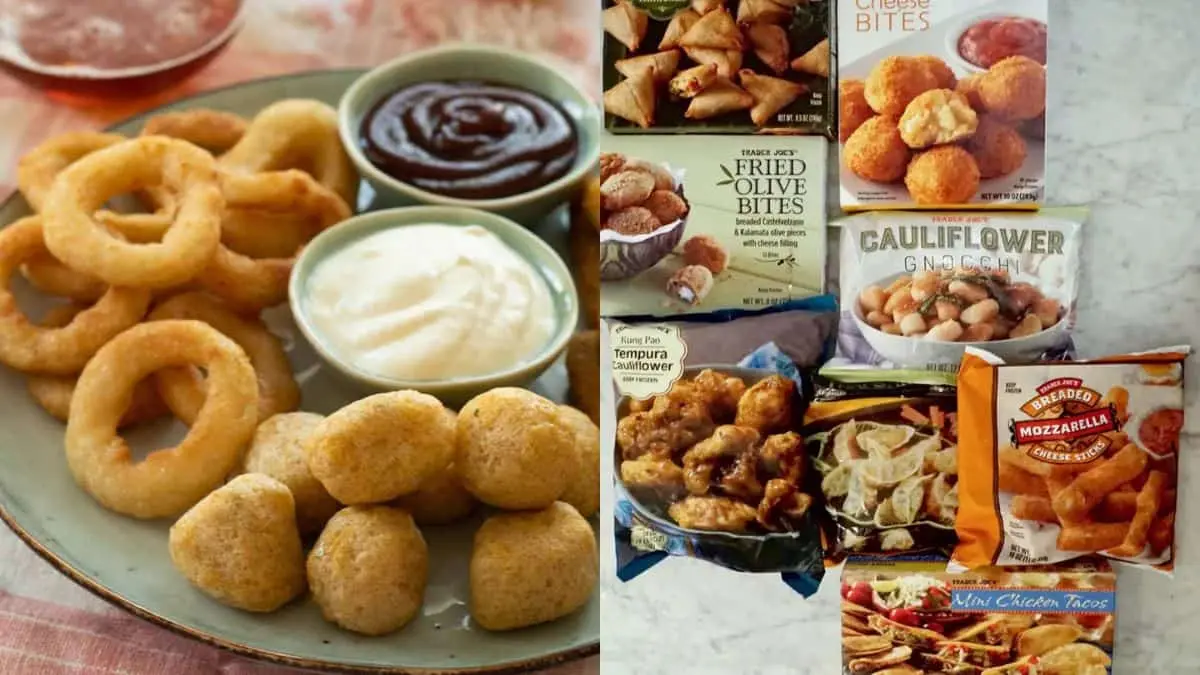If you’ve just unboxed your shiny new air fryer, you might be wondering—do you actually need oil? After all, isn’t the whole point of an air fryer to cook with less oil?
Well, yes and no. Air fryers use hot air to crisp up food, but a little oil can make a huge difference. It helps food brown evenly, keeps it from drying out, and gives that golden, crispy texture you love. But here’s the catch—using oil the wrong way can ruin your results. Too much oil makes food soggy, the wrong oil can burn, and some application methods can even damage your air fryer.
That’s why in this guide, we’re breaking down exactly how to use oil in an air fryer the right way. From choosing the best oils to applying them properly, you’ll learn everything you need to get crispy, delicious results—without the greasy mess. Let’s dive in!
Do You Need Oil in an Air Fryer?
The short answer? Sometimes.
Air fryers work by circulating super-hot air around your food, mimicking the crispiness of deep-frying—but without dunking everything in oil. That said, adding a little oil can make a big difference, especially if you want better texture, flavor, and even cooking.
When You Should Use Oil
- For crispy results – A light coating of oil helps brown food evenly and gives that signature crunch.
- To prevent dryness – Lean meats, vegetables, and some frozen foods can dry out without a bit of oil.
- For seasoning to stick – Oil helps spices and seasonings stay on your food instead of falling to the bottom of the basket.
When You Can Skip the Oil
- Pre-oiled frozen foods – Many frozen fries, nuggets, and snacks already have oil added.
- Fatty meats – Bacon, sausages, and certain cuts of steak release enough natural fat as they cook.
- Baking in the air fryer – No oil is needed for cakes, muffins, or cookies.
So, while you don’t always need oil, using it correctly can take your air fryer meals to the next level. Up next, let’s talk about which oils work best—and which ones to avoid.
Best Types of Oil for Air Frying
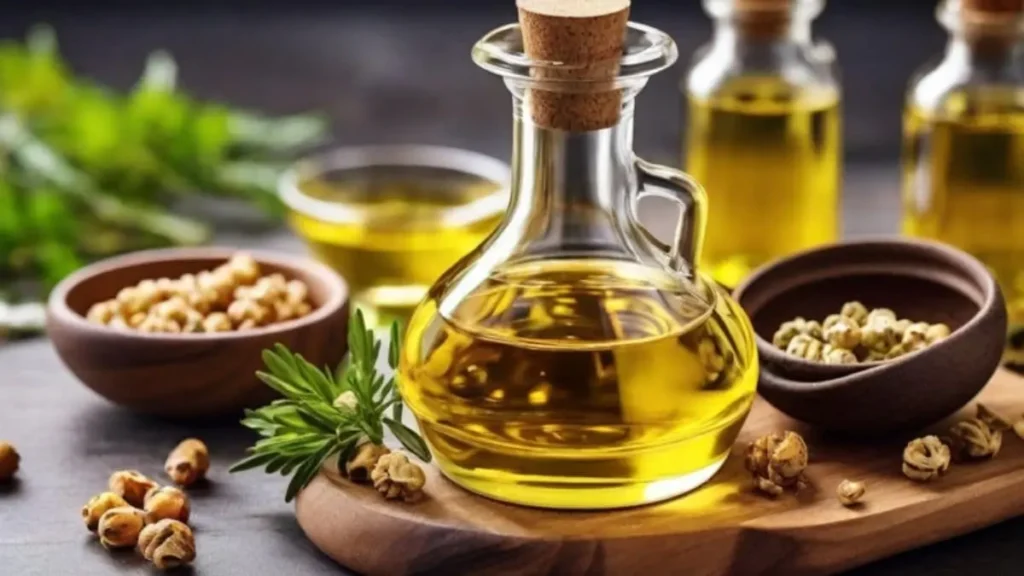
Not all oils are created equal, especially when it comes to air frying. Since air fryers cook food at high temperatures, the oil you use needs to handle the heat without smoking or burning.
Some oils work great for crisping up food, while others break down too quickly and can leave an unpleasant taste (or even release harmful compounds). Let’s break it down.
High Smoke Point Oils (Best for Air Frying)
The key to choosing the right oil for air frying is looking at its smoke point—the temperature at which it starts to burn. Since air fryers often cook between 350°F and 450°F, you need an oil that won’t start smoking before your food is done.
Here are some of the best oils for air frying:
Avocado Oil
Avocado oil is one of the best choices for air frying because it has a high smoke point of around 520°F. This means it can handle any air fryer temperature without burning. It’s also a healthier option, packed with heart-friendly monounsaturated fats. The flavor is mild, so it won’t overpower your food.
Canola Oil
Canola oil is another solid option, with a smoke point of 400°F. It’s affordable, neutral in flavor, and works well for air frying everything from vegetables to meats. Plus, it’s lower in saturated fat than some other oils, making it a relatively healthy choice.
Peanut Oil
If you’re frying foods like chicken wings or fries, peanut oil is a great pick. It has a smoke point of around 450°F and adds a subtle nutty flavor that works well with many dishes. However, if you have allergies in the household, you may want to skip this one.
Sunflower Oil
With a smoke point of around 450°F, sunflower oil is another excellent option for air frying. It has a light flavor that won’t interfere with the taste of your food, and it’s rich in vitamin E and healthy fats.
Light Olive Oil
You might have heard that olive oil isn’t great for air frying, but that’s only true for extra virgin olive oil (EVOO). Light olive oil has a higher smoke point of around 465°F, making it much better suited for high-heat cooking. It’s a great option if you want a mild olive flavor without the risk of burning.
Oils to Avoid in an Air Fryer
Just as some oils work well for air frying, others can cause problems. The biggest issue is low smoke points—oils that burn too easily can create a bitter taste, ruin your food, and even produce harmful fumes.
Extra Virgin Olive Oil (EVOO)
EVOO is fantastic for drizzling over food after cooking, but it’s not ideal for air frying. It has a smoke point of 375°F, which is on the lower end for air frying temperatures. If you love olive oil, stick to the lighter version.
Butter and Margarine
Butter and margarine might add great flavor, but they burn quickly because of their low smoke points (around 300-350°F). Instead of using them in your air fryer, brush them on food after cooking.
Unrefined Coconut Oil
Coconut oil is popular for baking and sautéing, but unrefined coconut oil has a low smoke point of about 350°F. It’s prone to burning, which can leave a bitter aftertaste. If you love coconut oil, go for the refined version, which has a slightly higher smoke point (about 400°F).
Flaxseed Oil & Walnut Oil
These oils are loaded with healthy fats but have very low smoke points (below 350°F). They’re best used in salad dressings or drizzled over food rather than cooked at high temperatures.
How to Use Oil in an Air Fryer (Step-by-Step Guide)
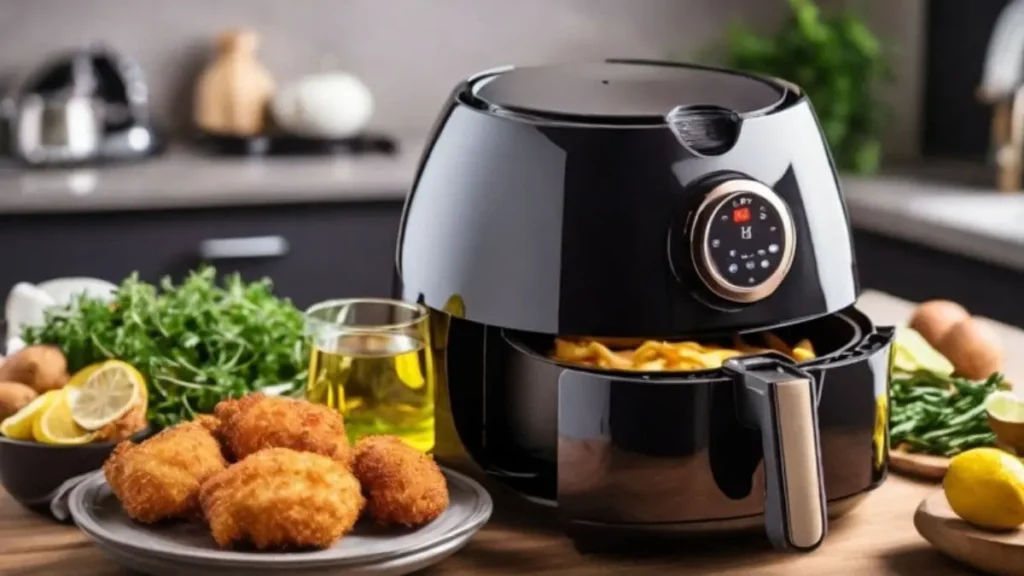
Using oil in an air fryer isn’t as simple as just pouring it in and hoping for the best. Unlike deep frying, where food is submerged in oil, air frying requires only a small amount to enhance crispiness and flavor. The trick is knowing which oil to use, how to apply it, and how much to use for different types of food. Follow this step-by-step guide to get the best results.
Step 1: Choose the Right Oil
Before you even start cooking, make sure you’re using an oil that’s suited for air frying. Since air fryers cook food at high temperatures, the oil you use needs a high smoke point to prevent burning and unwanted flavors.
For most recipes, avocado oil, canola oil, peanut oil, or sunflower oil are the best choices. These oils can handle high heat and won’t leave a burnt taste on your food. If you love olive oil, make sure to use light olive oil, as extra virgin olive oil has a lower smoke point and can burn easily.
On the other hand, avoid butter, margarine, and unrefined coconut oil in your air fryer. These fats burn too quickly and won’t give you the crispiness you’re looking for.
Step 2: How to Apply Oil Properly
Using oil the right way in an air fryer is key to getting crispy, evenly cooked food. Too much oil can make food soggy, while too little may leave it dry and bland. The goal is to apply just enough to create a thin, even coating.
The best way to apply oil is with an oil spray bottle. A fine mist of oil ensures that every part of the food gets coated without drenching it. If you don’t have a spray bottle, you can also toss your food in a small amount of oil before cooking. Just add a teaspoon or two to a bowl, mix well, and make sure everything is lightly coated.
For foods like chicken or fish, using a pastry brush to apply oil works well, especially if you want to target certain areas. Just dip the brush in oil and lightly coat the surface for a crisp, golden finish.
One thing to avoid is using store-bought aerosol cooking sprays like PAM. These sprays contain additives that can damage the nonstick coating of your air fryer over time. Instead, invest in a refillable spray bottle and use pure oil.
Step 3: Adjusting the Oil Quantity Based on Food Type
Not all foods need the same amount of oil. Some foods, like frozen French fries, already contain some oil, while others, like fresh vegetables, need a little more to crisp up properly.
For vegetables, a light mist of oil is usually enough. Tossing them in about ½ to 1 teaspoon of oil per cup of veggies helps them roast evenly and develop a nice char.
For proteins like chicken, steak, or fish, about ½ to 1 teaspoon per serving works well. If you’re cooking skin-on chicken, applying a little extra oil to the skin will help it crisp up beautifully.
For breaded or battered foods, using more oil is actually helpful. A generous spray of oil on the coating ensures that it crisps up properly instead of turning dry and powdery. If your breading looks pale mid-cook, give it another light mist of oil to enhance browning.
For frozen foods like fries, nuggets, or onion rings, check the package. Many of these foods already have some oil added, so you may not need extra. However, if they look dry, a quick spray before cooking can help them crisp up better.
Common Mistakes to Avoid When Using Oil in an Air Fryer
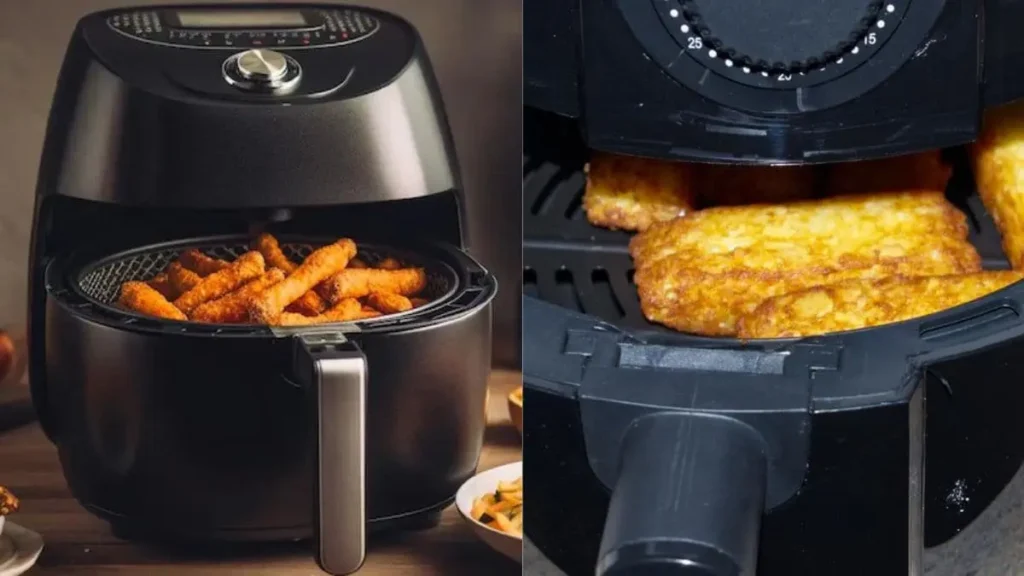
Even though using oil in an air fryer is simple, a few small mistakes can ruin your food’s texture or even damage your appliance. If your air-fried dishes aren’t turning out as crispy as you’d like, or if you’re noticing smoke or weird flavors, you might be making one of these common mistakes. Let’s break them down so you can get perfect results every time.
Using Too Much Oil
One of the biggest mistakes people make is thinking that more oil equals more crispiness. Unlike deep frying, air frying doesn’t require a lot of oil—too much can actually make your food soggy instead of crispy. Instead of frying, the excess oil just sits on the surface, preventing proper air circulation.
A light mist or about ½ to 1 teaspoon of oil per serving is usually enough. If you’re tossing food in oil, make sure it’s just lightly coated, not drenched. When in doubt, start with less—you can always add more if needed.
Using Aerosol Cooking Sprays
It might seem convenient to grab a can of PAM or another aerosol cooking spray, but don’t do it. These sprays contain additives like propellants and anti-foaming agents that can damage your air fryer’s nonstick coating over time. Eventually, this can lead to food sticking to the basket or the coating peeling off.
Instead, use a refillable oil spray bottle and fill it with pure oil. If you don’t have a spray bottle, brushing or tossing food in oil works just as well.
Applying Oil the Wrong Way
Another common mistake is adding oil directly to the air fryer basket instead of coating the food. Pouring oil into the basket can cause it to pool at the bottom, leading to smoking or burning. It also doesn’t help the food crisp up properly.
Instead, always apply oil to the food itself, not the basket. A light spray, toss, or brush of oil on the ingredients before cooking is the best method. If you’re cooking something with breadcrumbs, you may need to mist it again halfway through cooking to keep it from drying out.
Using the Wrong Type of Oil
Not all oils work well in an air fryer. Oils with low smoke points—like extra virgin olive oil, butter, or unrefined coconut oil—can burn at high temperatures, giving your food a bitter taste and even creating excess smoke.
Stick to high smoke point oils like avocado oil, canola oil, sunflower oil, or peanut oil. These can handle air frying temperatures without burning or breaking down.
Not Preheating the Air Fryer
Preheating your air fryer helps food cook more evenly and crisp up faster. If you skip preheating, your food sits in a warming-up basket, absorbing oil before it starts crisping. This can lead to a softer, less crispy texture.
If your air fryer has a preheat function, use it. If not, simply run it empty at the cooking temperature for 2-3 minutes before adding your food. This small step makes a big difference in texture.
Forgetting to Shake or Flip the Food
Some foods, like fries, chicken wings, or vegetables, need to be shaken or flipped halfway through cooking to crisp up evenly. If you forget this step, one side might end up perfectly crispy while the other stays soft.
Check your recipe—if shaking or flipping is recommended, set a timer to remind yourself to do it about halfway through cooking.
FAQs About Using Oil in an Air Fryer
Got questions about using oil in your air fryer? You’re not alone! Here are some of the most common questions people ask, with straightforward answers to help you get the best results.
What’s the best oil to use in an air fryer?
The best oils are those with a high smoke point, like avocado oil, canola oil, peanut oil, sunflower oil, and light olive oil. These oils can handle air fryer temperatures without burning or producing smoke.
Can I use olive oil in an air fryer?
Yes, but choose light olive oil instead of extra virgin olive oil (EVOO). EVOO has a lower smoke point and can burn at high temperatures, giving food a bitter taste.
How much oil should I use in an air fryer?
A little goes a long way. In most cases, ½ to 1 teaspoon per serving is enough. If using a spray bottle, a light mist should evenly coat the food without making it greasy.
Can I use cooking spray like PAM in my air fryer?
No, it’s best to avoid store-bought aerosol sprays. They contain additives that can damage the air fryer’s nonstick coating over time. Instead, use a refillable spray bottle filled with pure oil.
Do I put oil in the air fryer basket or on the food?
Always apply oil to the food, not the basket. Spraying or tossing food in oil before cooking ensures even crisping. Adding oil directly to the basket can cause pooling, smoking, or uneven cooking.
Why is my air fryer smoking when I use oil?
This usually happens if you’re using an oil with a low smoke point (like butter or EVOO) or if there’s leftover grease in the air fryer. Try using a higher smoke point oil and clean your air fryer regularly to prevent buildup.
Conclusion
Using oil in an air fryer isn’t complicated, but getting it right makes a big difference in texture, flavor, and overall results. The key is to choose the right oil, apply it properly, and use just the right amount—not too much, not too little. High smoke point oils like avocado, canola, and peanut oil work best, while aerosol sprays and low smoke point oils should be avoided.
Remember, air frying isn’t about drowning your food in oil—it’s about using just enough to enhance crispiness and prevent dryness. Whether you’re making crispy fries, juicy chicken, or perfectly roasted veggies, a little oil goes a long way. Now that you know how to use oil in your air fryer the right way, it’s time to put these tips to the test and start cooking!

